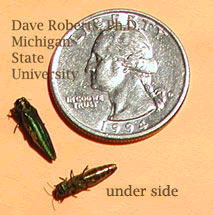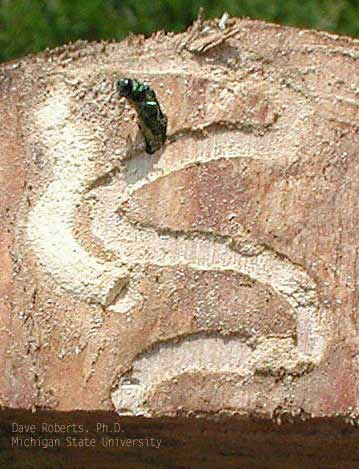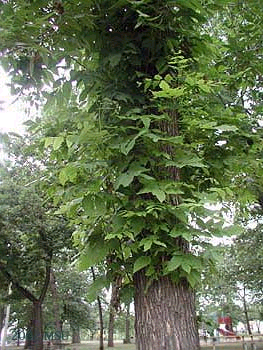Introduced Species Summary
Project
Emerald
Ash Borer ( Agrilus planipennis )
| Project Home | Taxonomy | Identification | Distribution | Introduction Facts | Establishment | Ecology | Benefits | Threats | Control |

Common Name:
Emerald Ash Borer
Scientific Name: Agrilus planipennis
Classification:
Phylum or Division:
Anthropoda
Class:
Uniramia (Insecta)
Order:
Coleoptera
Family:
Buprestidae
Subfamily:
Agrilus

Identification and Biology:
The adult Emerald Ash Borer is bright green in color. It
has has been described as boat-shaped and somewhat flattened, is between
7.5 - 13 mm, or about a half inch, in length and 1/16 inch wide, and the
females are larger than the males. Emerald Ash Borers are brighter and
larger than any native North American species of Agrilus. The adult body
is a metallic, golden or brassy green, with dark green wing covers, or elytra.
The tips of the elytra are rounded, with small teeth along the edges.
When the emerald color wings are open, the top of the abdomen, which is a
metallic copper-red, is visible. The first pair of legs is attached
to the prothorax, which is slightly wider than the head and the same width
as the base of the elytra. The back edges of the prothorax covering
are wavy, and the top of the prothorax has tiny, transverse ridges.
The larvae of the Emerald Ash Borer are cream colored. They reach a length of 26 to 32 mm, and are characterized by dorsal-ventral flattening. The brown head is mostly retracted into the prothorax, with only the mouthparts externally visible. The abdomen has ten segments, with pincer-like appendages attached to the last segment.
The adult Emerald Ash Borer emerges beginning in late May, through the end of June. During the day, particularly in warm and sunny conditions, the beetles are active. In inclement weather, including rain, strong winds, heavy cloud cover, or temperatures above 90 degrees Farenheit, and at night, they tend to stay protected in bark crevices or on foliage. They fly, usually not more than 2 meters above the ground. It is not known whether they can fly for long distances. Adults are present into August, and they can feed on up to half a square centimeter of foliage per day, leaving jagged edges to the parts of the leaves that they have eaten.

Adult males live approximately 13 days, and females live about 21 - 22 days. Females are able to mate multiple times. Oviposition (egg-laying) on the bark surface or within bark crevices begins 7 to 9 days following the initial mating, and each female lays between 65 and 90 eggs during its lifetime. In the affected areas in Michigan, this period extends into mid to late July. Eggs hatch in 7 to 10 days, and the larvae chew through the bark and enter the cambial layer. A larva feeds on phloem and the outer sapwood for weeks, carving an S - shaped feeding gallery which becomes larger as the larva grows.The galleries are typically packed with fine sawdust, or frass. A typical gallery is 20 - 30 cm. in length, although the length of the affected area can be anywhere from 10 to 50 cm. In some areas, woodpeckers seek out and feed on large quantities of larvae.
The insect remains in the larval stage throughout the winter, remaining
in a shallow chamber it has carved in the sapwood. Pupation starts
in late April or early May. The new adults may remain in the pupal
chamber for up to two weeks before finally emerging head-first from the wood
through a D-shaped exit hole in the bark that is 3-4 mm. in diameter.
Original Distribution: The Emerald Ash Borer is native to Eastern Asia. The insect is found in China, Korea, Japan, Mongolia, the Russian Far East, and Taiwan.
Current Distribution: Outside of its native range, the Emerald Ash Borer is currently known to exist in six counties in southeastern Michigan: Wayne, Washtenaw, Macomb, Monroe, Livingston and Oakland; and Windsor, Ontario, Canada.
Site and Date of Introduction: The particulars of the original introduction of the Emerald Ash Borer are unknown, but it appears that the insect has been in the Detroit area for approximately five years. It was officially identified in Michigan in July 2002.
Mode(s) of Introduction: The mode of introduction of the Emerald Ash Borer into Michigan is unknown.
Reason(s) Why it has Become Established: The main reason for the establishment of the Emerald Ash Borer in southeastern Michigan apears to be the prevalence of ash trees in that locale, and a lack of natural preditors. Also,the relatively temperate climate in southern Michigan allows for the maturation of the species and reproduction within a one year life cycle.
Ecological Role: The Emerald Ash Borer has been observed in Michigan only with regard to ash trees. It has attacked green (Fraxinus pennsylvanica), white (F. americana), and black (F. nigra) ash, as well as several other varieties of ash. Asian reports indicate that it has targeted a variety of native ash species in that part of the world.
As the larvae begin to create their S-shaped feeding tunnels under the bark of the infested tree, branches of the tree begin to die. Trees can lose 30 to 50 percent of their foliage, typically the upper third of the tree, in the first year. The trees will first thin and/or yellow, and then die back. Quite often, the tree will send out a profusion of shoots or sprouts, known as epicormic shoots, at the demarkation of the live and dead tissue on the trunk. These shoots grow very quickly with abnormally large foliage. Vertical splits may also appear in the bark as a result of the production by the tree of tissue in response to the larval feeding. The tree typically dies within a period of two to three years of infestation.
The Emerald Ash Borer has already killed or damaged hundreds of thousands of ash trees in its affected area in Michigan. Trees of all ages are affected, except for small seedlings under one-half inch in diameter.
Benefit(s): There are no environmental benefits to the presence of the Emerald Ash Borer.
Threat(s): The Emerald Ash Borer poses a significant threat to the population of ash trees in Southeastern Michigan and the surrounding region. It also poses a real economic threat, since ash is used in that area for firewood as well as timber products.
Control Level Diagnosis: This invasive insect is a serious threat to ash trees in the infested area.

Control Method:
In July 2002, the State of Michigan created an Emerald Ash Borer
Task Force as part of an Invasive Species Emergency Response Plan. Task
Force members include the Michigan Department of Agriculture, Michigan Department
of Natural Resources, Michigan State University, Michigan Technological University,
U.S. Department of Agriculture Animal and Plant Health Inspection Service
(APHIS), and the U.S. Forest Service.
The Michigan Department of Agriculture
has placed a quarantine on all ash trees and ash wood products, including
firewood, in the affected counties. Under the quarantine no ash trees, branches,
lumber, firewood, and wood chips larger than one inch in diameter may be
taken outside the six affected counties. All trees destroyed by the
insect are to be removed and destroyed. Trees with more than 50 percent
dieback are considered not able to be saved and are to be removed. On
trees with less heavy damage, affected limbs are to be removed and burned.
Wood boring beetles tend to be attracted to trees undergoing stress, particularly as a result of drought. Therefore, additional water and fertilizer given to ash trees may enable them to be more vigorous and resistant to the insects, although not to the point of excess, which may also cause stress. Certain insecticide treatments also may be considered for trees with limited damage.
In addition, it is recommended that ash not be used for replacement planting in affected areas. Diversity in plantings may be key to managing further potential losses in these areas.
An Emerald Ash Borer hotline has been established to report any movement of ash wood out of the quarantined areas or for further information at (866) 325-0023.
References:
"Emerald Ash Borer," Michigan Department of Agriculture
http://www.michigan.gov/mda/0,1607,7-125-1568_2390_18298-44151--,00.html"New Exotic Pest, the Emerald Ash Borer," by D.L. Roberts, Ph.D., Michigan State University Extension, July 17, 2002, Rev. 9/19/02
http://www.msue.msu.edu/reg_se/roberts/ash/index.html"New exotic pest identified in Michigan's Ash trees; State issues quarantine to control, prevent its spread," Michigan Department of Agriculture News Release, July 16, 2002
http://www.na.fs.fed.us/spfo/eab/pubs/nr/nr_mi.htm"Wood-Damaging Beetles," by Richard M. Houseman, Dept. of Entomology, University of Missouri-Columbia, Revised April 1, 2001
http://muextension.missouri.edu/xplor/agguides/pests/g07422.htm"State provides update on Emerald Ash Borer -- Exotic pest also found in Monroe County; quarantine expanded; Travelers, hunters reminded to NOT take ash trees, firewood outside of quarantined area, " Michigan Department of Agriculture, October 9, 2002
http://www.michigan.gov/mda/0,1607,7-125-1572_3628-53351--M_2002_10,00.html"Southeast Michigan residents warned of potential unwanted hitchhikers; Exotic insect that attacks ash trees can unknowingly be transported in firewood, products," Michigan Department of Agriculture, November 13, 2002
http://www.michigan.gov/mda/0,1607,7-125-1572_3628-56127--M_2002_11,00.html
Photo Credits:
http://www.michigan.gov/mda/0,1607,7-125-1568_2390_18298-44151--,00.html
Author: Leni
Darrow
Last Edited:
December 9, 2002
| Project
Home | Course
Home |